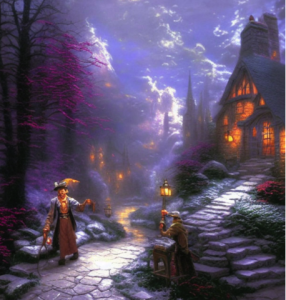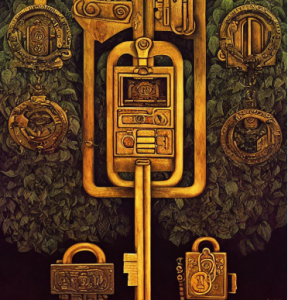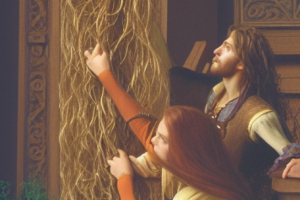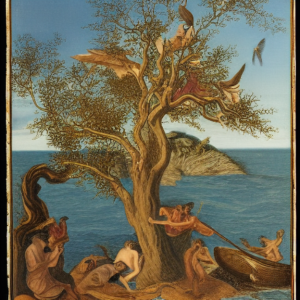The book has hardly changed in the thousands of years of its existence. Is that due to technology limits of the time, or was it nearly perfected in the years following its creation? Just as the printing press revolutionized the book and reading, how will digital affect the legacy of the book? This is a question that will be attempted to be answered in this blog post. This post will look into where the book is going, and some fun ideas for the book in the future.
Borsuk writes, “Headings, glosses, and titles might be written in red, as would dots and dashes used to separate sections and sentences” (17) Borsuk is talking about how Greek and Roman scribes would organize their manuscripts. If you look at any modern text book, the same thing still happens today. Chapters and sections are usually highlighted in a brighter color than the regular text which helps keep things organized and easy to find. The chapters and sections are also commonly separated by some kind of border that lets you know that these ideas are related to one another. This quote makes it hard to imagine that books will change much in the future. The very essence of what a book is has not changed much at all since it was created all those years ago.
The idea behind reading does not make a whole lot of sense, words and symbols are used to convey messages about stuff that happens in real life. That’s why in the future augmented reality will play a large part in how readers consume books. Borsuk says, “For example, in Quanzhou, there is a mountain whose cliffs are inscribed with maritime stories, such as historical accounts of Zheng He’s travels to the western ocean.” (35) In the future when we’re all wearing augmented reality glasses, I could see stories on landmarks or buildings of note. Say you’re in Seattle and you’re wearing your glasses and an icon pops up on the Space Needle. A story comes up and displays itself next to the actual landmark and tells you about the history of it and how it came to be. This idea could translate into reading anywhere that has a solid color, such as a wall or table. Borsuk writes, “Artists’ books showcase several historical forms that turn the book into a recombinant structure, allowing readers to create new juxtapositions within it.” (168) You could be in line at the DMV waiting to get a new license and you could just stare at a cream colored wall and enjoy reading your book through your glasses. This may seem like you would get some weird looks, but in the future people will be used to this and no one will even bat an eye at you. Augmented reality can also change how we interact with print books. As you read through the augmented glasses, they can conjure up certain scenes off to the side of the book. Maybe you’re reading a book from A Song of Ice and Fire and a dragon flies around the book while you read about it. The glasses can also track your eyes and get data from them. The glasses will be able to tell which word you stopped on and after a second of your eyes hovering over a word, they’ll generate the definition of that word without even asking. External links will also be implemented in case you want to buy or learn something more about the book you’re reading.
Artificial intelligence is another thing that will play a large part in books in the future. You’ll be able to set your own voice as the narration for the book you’re reading. I would personally never do this because I despise the sound of my own voice, but this is a neat feature that could have many different benefits. A prime use of this would be to preserve a loved one’s voice. Having a grandparents voice narrate a story for their grandchild would be a touching use of this technology, or using the voice of a long lost loved one. This could also save publishing companies by not having to pay a voice actor to narrate the story. Celebrities could make money by offering their voices as a download for users to buy. Imagine spending $19.99 on a Snoop Dogg voice download so you could listen to Pride and Prejudice with him. Artificial intelligence doesn’t stop at voices though. It could also generate images based on the story that you are reading. These could either pop up on your e-reader device, or could display through your augmented reality glasses. Artificial intelligence will also be able to create new stories based on your own experience. Say you’re riding the bus into town and go across the river. A story could be automatically generated about a bus riding protagonist who fights with a Godzilla type creature to keep the world safe. This ability would turn any boring task into an interesting event. Virtual reality gets a lot of the hype nowadays, but I personally think that augmented reality may be the bigger technology in the future.
An unfortunate drawback of digital books in the future will be the addition of ads. Take a look at YouTube and how long it can take to watch a video. Some videos can have ads that take over 5 minutes to sit through. Amazon sells Kindles at discounted prices if you’re okay with it being loaded with ads. With how absurd ads are becoming in digital media, they’ll soon make their way into digital books. If you take your eyes off of the screen for more than 10 seconds, an ad will pop up and won’t go away until you’ve stared at it for 5 seconds. Ad’s will also be planted at the end of chapters because most people will stop their reading at that point. Travel companies will have external links to the destination of the book you’re reading. While you are reading a book about someone traveling Europe, every new location will have a link to flights and hotels around that area. You’ll even get a discount because you have auto pay and you can book the flight and hotel with just a touch of the screen.
I think authors will still be in the same situation that they are in now. If you have a big following, or are a big name, you’ll have lucrative contracts that can make you some big bucks. What changes the most is the ease of self publication. While the big publishing companies will be making tons of money as always, more and more people will be able to publish their first book thanks to how easy it will be in the future. We’re basically at a point now where you can write a story and basically get it printed with the touch of a button. Being able to print on demand will only be more advanced in the future. Maybe in the future printers will be so advanced that they can create a physical book from a digital one you own with just a click of a button.
Despite all of this digital talk, I truly believe that physical books will stand the test of time. Humans love tactile things. They feel good in our hands as well as looking good on our shelves. The example that I would use for this are records. A technology that was invented over one hundred years and you can still get records for a lot of new music. A physical item is a talking point, it’s something that you can display. It’s hard to imagine going over to someone’s house and inquiring about their digital book library. Another drawback to digital books is that you may not actually own them, you just have the rights to read them, while unless you got the physical book from a library, you own it. Analog books also have the benefit of not needing another technology in order to use it. It doesn’t need a cell phone, a Kindle, a laptop, or even electricity in order to be accessed.






